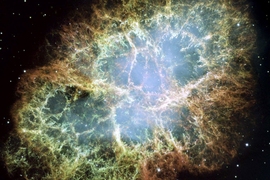Vast interstellar events where clouds of charged matter hurtle into each other and spew out high-energy particles have now been reproduced in the lab with high fidelity. The work, by MIT researchers and an international team of colleagues, should help resolve longstanding disputes over exactly what takes place in these gigantic shocks.
Many of the largest-scale events, such as the expanding bubble of matter hurtling outward from a supernova, involve a phenomenon called collisionless shock. In these interactions, the clouds of gas or plasma are so rarefied that most of the particles involved actually miss each other, but they nevertheless interact electromagnetically or in other ways to produces visible shock waves and filaments. These high-energy events have so far been difficult to reproduce under laboratory conditions that mirror those in an astrophysical setting, leading to disagreements among physicists as to the mechanisms at work in these astrophysical phenomena.
Now, the researchers have succeeded in reproducing critical conditions of these collisionless shocks in the laboratory, allowing for detailed study of the processes taking place within these giant cosmic smashups. The new findings are described in the journal Physical Review Letters, in a paper by MIT Plasma Science and Fusion Center Senior Research Scientist Chikang Li, five others at MIT, and 14 others around the world.
Virtually all visible matter in the universe is in the form of plasma, a kind of soup of subatomic particles where negatively charged electrons swim freely along with positively charged ions instead of being connected to each other in the form of atoms. The sun, the stars, and most clouds of interstellar material are made of plasma.
Most of these interstellar clouds are extremely tenuous, with such low density that true collisions between their constituent particles are rare even when one cloud slams into another at extreme velocities that can be much faster than 1,000 kilometers per second. Nevertheless, the result can be a spectacularly bright shock wave, sometimes showing a great deal of structural detail including long trailing filaments.
Astronomers have found that many changes take place at these shock boundaries, where physical parameters “jump,” Li says. But deciphering the mechanisms taking place in collisionless shocks has been difficult, since the combination of extremely high velocities and low densities has been hard to match on Earth.
While collisionless shocks had been predicted earlier, the first one that was directly identified, in the 1960s, was the bow shock formed by the solar wind, a tenuous stream of particles emanating from the sun, when it hits Earth’s magnetic field. Soon, many such shocks were recognized by astronomers in interstellar space. But in the decades since, “there has been a lot of simulations and theoretical modeling, but a lack of experiments” to understand how the processes work, Li says.
Li and his colleagues found a way to mimic the phenomena in the laboratory by generating a jet of low-density plasma using a set of six powerful laser beams, at the OMEGA laser facility at the University of Rochester, and aiming it at a thin-walled polyimide plastic bag filled with low-density hydrogen gas. The results reproduced many of the detailed instabilities observed in deep space, thus confirming that the conditions match closely enough to allow for detailed, close-up study of these elusive phenomena. A quantity called the mean free path of the plasma particles was measured as being much greater than the widths of the shock waves, Li says, thus meeting the formal definition of a collisionless shock.
At the boundary of the lab-generated collisionless shock, the density of the plasma spiked dramatically. The team was able to measure the detailed effects on both the upstream and downstream sides of the shock front, allowing them to begin to differentiate the mechanisms involved in the transfer of energy between the two clouds, something that physicists have spent years trying to figure out. The results are consistent with one set of predictions based on something called the Fermi mechanism, Li says, but further experiments will be needed to definitively rule out some other mechanisms that have been proposed.
“For the first time we were able to directly measure the structure” of important parts of the collisionless shock, Li says. “People have been pursuing this for several decades.”
The research also showed exactly how much energy is transferred to particles that pass through the shock boundary, which accelerates them to speeds that are a significant fraction of the speed of light, producing what are known as cosmic rays. A better understanding of this mechanism “was the goal of this experiment, and that’s what we measured” Li says, noting that they captured a full spectrum of the energies of the electrons accelerated by the shock.
"This report is the latest installment in a transformative series of experiments, annually reported since 2015, to emulate an actual astrophysical shock wave for comparison with space observations," says Mark Koepke, a professor of physics at West Virginia University and chair of the Omega Laser Facility User Group, who was not involved in the study. "Computer simulations, space observations, and these experiments reinforce the physics interpretations that are advancing our understanding of the particle acceleration mechanisms in play in high-energy-density cosmic events such as gamma-ray-burst-induced outflows of relativistic plasma."
The international team included researchers at the University of Bordeaux in France, the Czech Academy of Sciences, the National Research Nuclear University in Russia, the Russian Academy of Sciences, the University of Rome, the University of Rochester, the University of Paris, Osaka University in Japan, and the University of California at San Diego. It was supported by the U.S. Department of Energy and the French National Research Agency.








